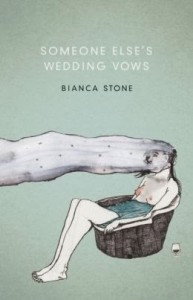What We’re Reading: Someone Else’s Wedding Vows

 Someone Else’s Wedding Vows by Bianca Stone (Tin House Books and Octopus Books, 2014)
Someone Else’s Wedding Vows by Bianca Stone (Tin House Books and Octopus Books, 2014)
Human relationships—from familial and fraternal to romantic and sexual—have always provided material for poets. And there is no better event for observing all types of relationships than at a wedding, a truly literal and figurative joining of two groups of families and friends. In her new collection, Someone Else’s Wedding Vows, Bianca Stone offers her creative insights into various relationships.
The title poem, “Someone Else’s Wedding Vows,” was inspired by assisting her sister, a wedding photographer, at a few events. The narrator is a wedding photographer lamenting her own relationships and choices in life as she photographs someone else’s big day.
And it’s true
I spent my whole life in fear of sharing my mind
but with a longing for it to be taken.
Year after year I could not even order myself to be touched.
I became a waitress who looked sad, dropping occasionally
into the bed of a maniac, who looked sadder
and meaner.
In an interview with TellTell Poetry, Stone states that after observing the weddings she realized “[s]omeone else’s vows are meaningless, and yet, they’re all so analogous. It both revolted and excited me.” As “Someone Else’s Wedding Vows” comes to a close, the narrator offers her own toast.
And where it’s driest I sit down with my wet drink.
I drink for the incidental. The heart of dust.
For my family and all their uneven moods.
For this audience of discreet psychotics
posing for photographs.
For the living deer ravaging gardens.
For the touch of sub-shrubs: lavender,
periwinkle and thyme—
touching the lingering otherness—
for this not being known,
rarely knowing
and for the ordinary monstrous knowing I love.
Stone’s poems succeed with her use of creatively mundane imagery. She declares, “My name looks good in gangster font” when considering her educational degrees in “The Future is Here.” She laments her flatlining intellect in “Dishes”—“Now my intelligence is a line of hieroglyphs, / a blouse fluttering.”
In the final poem, “Practicing Vigilance,” Stone begins with a startling, yet entirely apt, image.
Every day I try and write down one terrible thing.
One terrible thing—I’m filled with them,
carry each one
like an organ locked in a Coleman cooler.
The terrible things in your life, whether they’re things you’ve done or thought or had done to you, can be as simultaneously revolting and awe-inspiring as the organ in the cooler, and like the organ, sometimes you need those terrible things to survive. Because they are, and always will be, a part of you.
But by the end of the poem, Stone succinctly gets to the heart of all human relationships.
I’m coaxing the black bull out of my mouth
with a red flag and a beer. I’m constructing
out of my faulty genes,
my last sentence, my last thing
which addresses the dilemma obliquely:
we will perceive our own pain in others.
And we will know if we are capable of loving them.
We aren’t alone in suffering terrible things in our lives. Everyone has their own set of terrible things. It’s only a matter of finding a set of organ coolers we are willing and able to love.
Stone uses her worthy insights to deconstruct and analyze human relationships in the poems of Someone Else’s Wedding Vows, but she is also an accomplished visual artist, having created ink-and-watercolor comics and videos using her poems. Although there are no illustrations in Someone Else’s Wedding Vows, parts of some poems have been previously illustrated and can be viewed on her website. She described her use of illustration in a 2012 interview with The Comics Journal, “In my work I prefer to have the images move away from literal illustration of what the text is saying. I want to use the image as another element of form in poetry—to have the image offer more space for the reader to interpret and create meaning on their own.” Perhaps in her first full-length collection, Stone wanted the poetry to stand on its own. Speaking with Poetry Foundation, Stone admits, “I don’t want to tell anybody how to interpret a poetic line. It’s not good for the poem.” Stone did the cover illustration for Someone Else’s Wedding Vows, but I do wish more of her art had been included. The poetry, while strong on its own, is a whole new experience with the visuals (view her video for “Elegy with Judy Garland & Refrigerator” here).
Do illustrations enhance or diminish poetry? If combined with other media, does a poem become something other than a poem?





